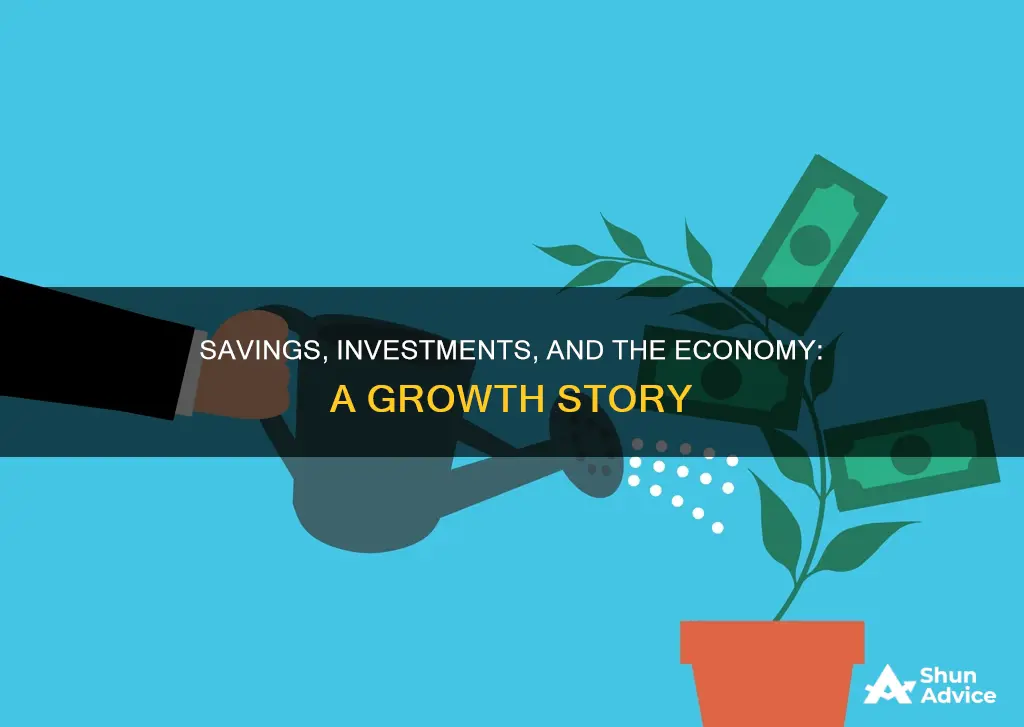
Saving and investing are both money management tools that are related to economic growth. Saving is setting aside money for emergencies or future purchases, while investing is buying assets such as stocks, bonds, or real estate with the expectation of making money. These two activities are linked to economic growth through the stimulation of investment, production, and employment, which leads to greater sustainable economic growth. Countries with higher savings rates tend to have faster economic growth as capital accumulation provides additional income streams and greater opportunities for production and innovation. Additionally, savings can help reduce a country's dependence on foreign direct investment, decreasing the risks associated with volatile foreign investment. On a personal level, higher savings reserves can help individuals cope with financial hardships, such as increased mortgage payments or job losses, ultimately contributing to faster economic recovery.
What You'll Learn
- Savings stimulate investment, production, and employment, generating sustainable economic growth
- Countries with higher savings rates tend to have faster economic growth
- Savings can reduce the need for foreign investment and the risks associated with it
- Savings can help individuals and countries cope with financial hardship and reduce the need for government stimulus
- Savings and investment are linked in the loanable funds market, where more savings lead to more investment

Savings stimulate investment, production, and employment, generating sustainable economic growth
Savings and investments are key drivers of economic growth, and this relationship is well understood by economists. Savings stimulate investment, production, and employment, generating sustainable economic growth.
Firstly, savings provide the capital for investment. When individuals save, they are, in effect, deferring consumption, and this saved money can then be used for investment, which generates economic growth. This is particularly important in developing countries, where the largest source of financial capital is often savings deposited in commercial banks. Savings can also reduce a country's dependence on volatile foreign direct investment, decreasing the risk of economic shocks.
Secondly, savings can stimulate production and innovation by providing an additional income stream for businesses. This increased capital can be invested in expanding operations, purchasing new equipment and technology, and hiring more employees. This leads to increased productivity and output, driving economic growth.
Thirdly, savings can help to lower interest rates, making it more affordable for businesses and individuals to borrow money for investments. As more people save, the supply of loanable funds increases, causing interest rates to drop. Lower interest rates encourage more borrowing for investment purposes, further stimulating economic growth.
Finally, savings can also have a stabilising effect on the economy during tough economic times. When economic downturns occur, individuals and businesses with savings are better equipped to weather the storm. They can continue to invest, maintain production, and avoid layoffs, helping to mitigate the negative impact on the broader economy.
In summary, savings play a crucial role in stimulating investment, production, and employment, which are all key drivers of sustainable economic growth. While saving money is always prudent advice, it is essential to recognise that savings have far-reaching implications for the economy as a whole.
Ireland's Savings vs Investments: A Balancing Act
You may want to see also

Countries with higher savings rates tend to have faster economic growth
A country with a high national savings rate is not dependent on foreign direct investment, and the risk arising from volatile foreign direct investment decreases significantly. For example, Kosovo, which has experienced significant economic growth, has been able to reduce its dependence on foreign direct investment by increasing its national savings rate. This has resulted in a more stable economy that is less vulnerable to external factors.
Additionally, countries with higher savings rates have more financial resources available for investment. This is especially important for developing countries, which often rely heavily on foreign investment to fund their development. By increasing domestic savings, these countries can reduce their dependence on external sources and gain more control over their economic growth.
Furthermore, higher savings rates can lead to higher investment rates, which drive economic growth. This is because savings provide the necessary resources for financial independence and sustained economic growth. For instance, oil-rich countries like Qatar and Brunei have high savings rates due to their oil exports, which also contribute to their economic growth.
However, it is important to note that the relationship between savings and economic growth is complex, and other factors, such as income levels, low taxes, and foreign investment, also play a role. Additionally, while saving is generally beneficial, excessive saving can lead to recessions, as described by economist John Maynard Keynes in the "paradox of thrift."
Yuan Pay Group: Your Guide to Investing in China's Digital Currency Revolution
You may want to see also

Savings can reduce the need for foreign investment and the risks associated with it
Savings and investments are closely related to a country's economic growth. Economists define saving as consuming less in the present to be able to consume more in the future. This adds to the stock of capital, which in turn can be invested to generate greater economic growth.
A country with a high national savings rate is not dependent on foreign direct investment. This reduces the risk arising from volatile foreign direct investment. Foreign savings are not a good substitute for domestic savings, as large and persistent current account deficits can lead to abrupt ends to growth. Episodes of high growth financed by foreign savings often end with a sharp slowdown in investment, and growth over the whole period is slower than when countries rely on domestic savings.
For example, a study of Kosovo's economy between 2010 and 2017 found that savings have a significant positive impact on economic growth. The study confirmed that countries with high national savings rates are not dependent on foreign direct investment, and so the risks from volatile foreign investment are significantly reduced.
In addition, high rates of personal savings can speed up a country's economic recovery. For example, in the aftermath of the Great Recession, the national savings rate in the US shot up, and this helped to shore up the nation's finances at the consumer level. This meant that there was less need for government stimulus, which can work against savers by increasing inflation and increasing the risk of inflation.
Therefore, savings can reduce the need for foreign investment and the risks associated with it. Countries with high savings rates have greater capital available for investment, which can be used to stimulate investment, production, and employment, generating greater sustainable economic growth.
New Media Investment Group Merger: When Will It Be Finalized?
You may want to see also

Savings can help individuals and countries cope with financial hardship and reduce the need for government stimulus
Savings can play a crucial role in helping individuals and countries navigate through financial hardships and reduce the reliance on government stimulus measures. Here are some ways in which savings can provide a buffer during challenging economic times:
For Individuals:
- Emergency Fund: Building an emergency fund is essential for individuals to weather unforeseen financial crises, such as accidents, job losses, or unexpected expenses. Having savings set aside can reduce stress and provide immediate financial support when emergencies arise. It is generally recommended to aim for three to six months' worth of expenses in an emergency fund, but any amount saved can be beneficial.
- Financial Planning: Individuals can incorporate savings into their spending plans by tracking income and expenses and setting aside a portion of their income for savings. This can include automatic withdrawals from paychecks or recurring deposits into savings accounts. Additionally, contributing to retirement accounts, such as an individual retirement account (IRA) or employer-matched retirement plans, can be a tax-advantaged way to save for the future.
- Reduced Vulnerability: Maintaining savings can make individuals less vulnerable to economic downturns and reduce their reliance on credit, which can lead to debt accumulation and default risks. By having savings, individuals can avoid the negative consequences of high-interest debt and maintain their financial stability.
- Absorbing Expenses: Higher savings reserves give individuals a financial cushion to absorb unexpected or overwhelming expenses without falling into debt. This can include covering essential living expenses, such as mortgage payments, utilities, and groceries, during periods of reduced income or unemployment.
For Countries:
- Stimulating Investment: Savings contribute to the overall capital accumulation within a country, providing additional income streams for investment in production, innovation, and employment. This stimulates economic growth and reduces the need for foreign direct investment, making the country less dependent on volatile foreign capital inflows.
- Faster Economic Recovery: Countries with higher national savings rates tend to experience faster economic recovery during downturns. This is because higher personal savings rates shore up the country's finances at the consumer level, reducing the need for extensive government stimulus measures.
- Reduced Government Debt: When individuals save more, governments may have less need to borrow money or print additional currency to fund stimulus packages. This can lower the burden of sovereign debt on future generations and reduce the risk of inflation, which erodes the purchasing power of savings.
- Increased Financial Stability: Encouraging domestic savings can help countries achieve sustainable economic development and reduce their vulnerability to external shocks. It provides a stable base for investment and growth, making the country less dependent on foreign financing and less susceptible to economic downturns.
The Retirement Dilemma: Pay Off Debt or Invest?
You may want to see also

Savings and investment are linked in the loanable funds market, where more savings lead to more investment
The loanable funds market is a hypothetical market that demonstrates how loans from savers are allocated to borrowers with investment projects. In this market, the price is the interest rate, and the commodity being exchanged is money. Households act as suppliers of money by saving, and they will supply a larger quantity of money (i.e., save more) as the interest rate increases. This is because the interest rate is the return on savings, so a higher interest rate incentivises saving.
Businesses, on the other hand, are the demanders in the loanable funds market. They borrow money from households to make real investments, such as purchasing new equipment or upgrading software. As is usually the case, demand declines with price. In the loanable funds market, this means that the lower the interest rate, the greater the amount of money businesses will want to borrow, as the interest rate is the cost of taking out a loan.
The supply of loanable funds is based on savings, and the demand for loanable funds is based on borrowing. The interaction between the supply of savings and the demand for loans determines the real interest rate and the amount loaned out.
The loanable funds market is an important concept in understanding how savings and investment are linked. Through this market, household savings are channelled into business loans for investment. As a result, any income that is not spent (i.e., saved) becomes investment, a type of spending. This ensures that Say's Law holds: supply creates its own demand, and if there is insufficient demand to purchase the supply, price adjustments will correct the imbalances.
In the loanable funds market, investment is financed through loans, which are funded by households' savings. Therefore, saving is seen as the fundamental engine for economic growth. Investment in machines, research and development, software upgrades, etc., increases productivity, which in turn spurs overall economic growth.
An increase in the thriftiness or desire to save among households will shift the supply of loanable funds to the right, leading to a lower interest rate and a greater quantity of loaned funds. At a lower interest rate, the cost of borrowing for investment is lower, so more businesses will be willing to make greater investments.
Conversely, if households desire to save less and spend more of their income, moving the loanable funds supply curve to the left, the result will be a higher interest rate and lower levels of investment. In this scenario, households are enjoying more of their income through current consumption, but at the expense of investing in productivity growth for the future.
The link between savings and investment through the loanable funds market has been observed in developing countries such as Kosovo. Studies have shown that an increase in the accumulation of savings in commercial banks in Kosovo has had a positive effect on the country's economic growth. This is because savings stimulate investment, production, and employment, generating greater sustainable economic growth.
In summary, the loanable funds market demonstrates that savings and investment are closely linked, with household savings being channelled into business investments through loans. This ensures that income not spent (i.e., saved) becomes investment spending, maintaining the balance between supply and demand. The interest rate acts as a mechanism to balance the supply of savings and the demand for loans, with higher interest rates incentivising saving and lower interest rates encouraging investment.
Understanding Investment Fees: Uncovering the True Cost
You may want to see also
Frequently asked questions
Saving is setting aside money for emergencies or future purchases, while investing is buying assets such as stocks, bonds, or real estate with the expectation of making money. Saving typically involves less risk and provides quicker access to funds, whereas investing often carries more risk and may be less liquid but has the potential for higher returns.
Savings stimulate investment, production, and employment, leading to sustainable economic growth. Higher savings rates provide additional income streams for countries, encouraging domestic investment and reducing the need for foreign investment. This, in turn, decreases the risks associated with volatile foreign direct investment.
Investing provides capital for businesses, enabling them to expand, innovate, and create jobs. It also contributes to the development of new products and services, which can drive economic growth. Additionally, investments in the stock market and bonds can help companies fund their operations and projects, fostering economic growth.







